Content
- What is it, types, how to make it
- Composition and process of obtaining
- Applications
- How to cook yourself
- For rinsing the nose
- For nebulizer
- For contact lenses
- How to dilute the solution?
- How to warm up the solution?
- Inhalation dosage
- Adding other medications
- Komarovsky's advice
- Video on how to make saline
Make saline for rinsing the nose, nebulizer or contact lenses are easy. The home cooking process takes place in several stages. Depending on the purpose, the composition of the saline solution may vary.
What is it, types, how to make it
You can make saline at home yourself. It is widely used in almost all areas of medicine. Saline helps restore water and electrolyte balance in the body. It is also used for detoxification, for washing wounds and diluting medicines.
Saline or sodium chloride is an electrolyte responsible for maintaining the osmotic (hydrostatic) pressure in the cells of the human body. Almost all types of solutions are isotonic to plasma.
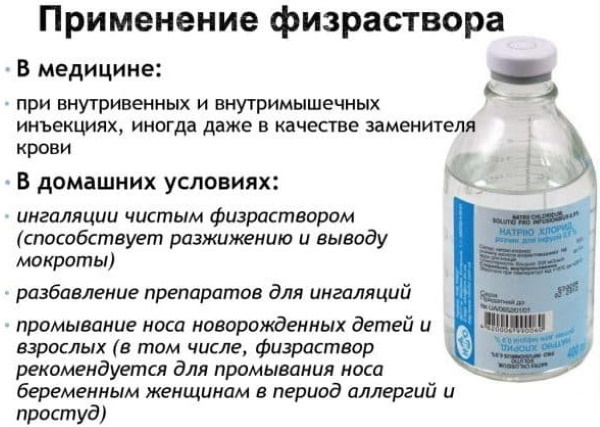
There are several main types:
| A type | Description |
| Trisol, disol, acesol | Standard saline solution to which various components are added (acetic acid salts, sodium bicarbonate, potassium salt of hydrochloric acid). |
| Ringer-Tyrode solution | Analogue of Ringer's solution. The composition is standard, the concentration of salts is usually different. |
| Ringer-Krebs solution | In addition to the standard components, the physiological solution contains a monosaccharide (dextrose), sodium bicarbonate, a salt of magnesium acid with hydrochloric acid, and a salt of orthophosphoric acid. |
| Ringer-Locke solution | Analogue of standard saline solution. The composition additionally includes sodium bicarbonate and dextrose. The solution restores the balance of alkalis and acids. |
| Ringer's solution | Multi-component saline solution. It is similar in composition to plasma. |
Sodium chloride is marketed in several formulations.
At the pharmacy you can buy:
- ampoules (0.9% solution) with a volume of 20 ml, 10 ml, 5 ml (for diluting medicines);
- vials (0.9% solution) with a volume of 1000 ml, 400 ml, 200 ml, 100 ml (external use, drip infusion, enemas);
- vials (10% solution) with a volume of 400 ml and 200 ml;
- pills (0.9 g, oral use).
The saline solution for nasal rinsing is sold in the form of a spray (the volume of the bottle is 10 ml).
Composition and process of obtaining
The main component in the saline solution is sodium chloride (NaCl). The substance is white friable crystals, readily soluble in liquid. The mass of the component is 58.43 g / mol. An isotonic solution contains up to 9 g and approximately 1000 ml of water. In the hypertensive type, 100 g of sodium chloride and 1000 ml of water are present.
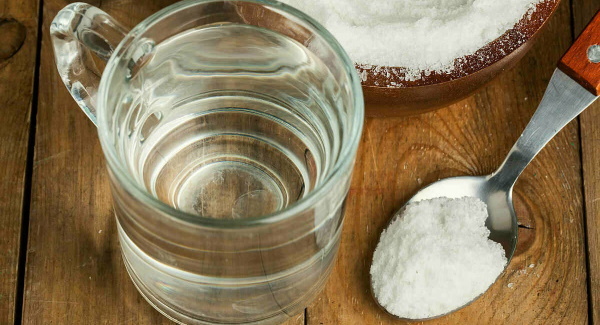
To prepare saline at home, it is enough to mix both ingredients together. The main condition is that the water must be distilled. No special equipment is required to obtain the liquid. Water is converted into distillate at home. A clear liquid is formed during evaporation due to the leveling of metals, macro-, microelements and salts. The collected steam can be converted into a distillate by boiling water.
The main methods of obtaining:
- collection and settling of rainwater;
- freezing;
- evaporation.
Distillate from rainwater can be obtained by people living in an industrially unpolluted area.
Applications
Making a saline solution at home from several components is quite simple. It is used in pediatrics, otolaryngology, neurology, traumatology, surgery and other fields of medicine. The concentration of salts in sodium chloride solution fully corresponds to the isothermal composition of the plasma. Saline can be administered intramuscularly and intravenously (drip, jet). The main purpose of application is to maintain osmotic intracellular pressure.
A deficiency of salts in the human body increases the risk of developing the following diseases:
- hypochloremia;
- hyponatremia;
- pathology of the digestive tract;
- dysbiosis;
- dehydration;
- pathology of the circulatory and nervous systems.
In people with hypochloremia and hyponatremia, both convulsions and profuse vomiting are diagnosed.
In a hospital, saline solution is used:
- for diseases accompanied by local allergic reactions;
- with sinusitis, tonsillitis, rhinitis;

- with a coma of a diabetic type;
- with profuse blood loss;
- with burns of 40% of the body and above.
The lyophilisate is diluted with saline. The drug can be used during inhalation and for rinsing the nose. Despite its high efficiency, the saline solution has a number of absolute restrictions on its use.
These include:
- potassium deficiency;
- excess extracellular fluid;
- an excess of sodium and chlorine in the body;
- acute renal and heart failure;
- swelling of the brain and lungs.
The simultaneous use of corticosteroids and saline is strictly prohibited.
In people prone to allergic reactions, when using saline as directed, the following side effects may develop:
- pain in the epigastric region;
- diarrhea;
- bouts of nausea;
- increased sweating;
- weakness;
- dizziness;

- migraine;
- tachycardia;
- heartburn caused by increased acidity;
- swelling.
The side effects that developed with the use of saline also include various dyspeptic disorders.
How to cook yourself
Homemade saline should not be administered subcutaneously, intramuscularly, or intravenously. In this case, the product will be non-sterile. For injections, use saline in pharmacy vials or ampoules.
Sodium chloride helps to cleanse the intestines. A self-prepared solution can be taken for constipation and poisoning. It helps induce vomiting and restore intestinal motility. If the patient has no appetite, then dectrosis can be added to the sodium chloride solution.
Saline prepared on your own can also be used to flush the throat for tonsillitis, laryngitis, tracheitis, and pharyngitis. The product has no age restrictions, it can be used while carrying a baby and during breastfeeding. A self-prepared solution must first be decanted.
For rinsing the nose
You can make a saline solution at home for rinsing the nose using table salt. Even healthy people can rinse their nose with saline. As a preventive measure for sinusitis with rhinitis, the procedure is carried out 4-5 times a day every 2-3 hours.
Saline solutions should not be used to rinse the nose of hypersensitive people. In this case, after the procedure, there is a high risk of discomfort (burning of the mucous membrane, sneezing). It is necessary to refrain from carrying out a hygienic procedure at a high temperature. Rinsing the nose helps to loosen dry crusts and makes breathing easier.
Algorithm for preparing saline solution:
- Bring 250 ml of water to a boil and cool to room temperature;
- dissolve 5 g of table salt in a liquid (if iodized salt is used during the preparation process, then iodine does not need to be added to the finished solution);
- mix the solution thoroughly;
- in the presence of sediment, drain the product.
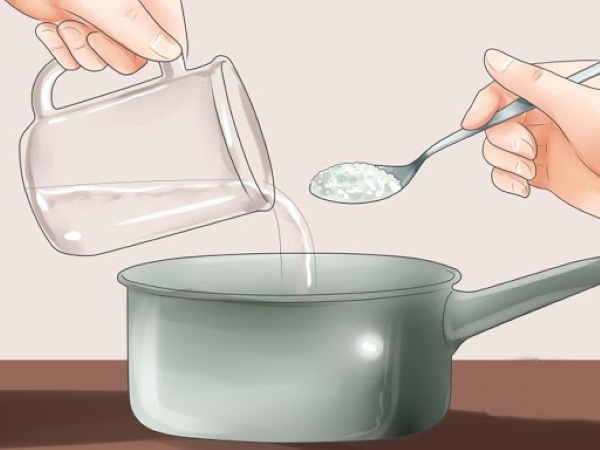
Table salt can be replaced with sea salt. In this case, the proportions will change slightly: by 1 tbsp. l. salt accounts for 1000 ml of boiled warm water. If you need to rinse the child's nose, then dissolve 1/2 tsp in a glass of liquid. l. cookery or 1/4 tsp. l. sea salt.
Physiological solution at home can be prepared in another way:
- Boil 300 ml of cold water and cool to room temperature;
- add 2.5 g of sodium chloride and baking soda (about 0.2-0.3 g) to the liquid;
- Stir the solution thoroughly, if a precipitate has formed, drain.
The product is completely safe for adults and children (provided that the patient does not suffer from hypersensitivity). If there are contraindications for the use of saline, you must contact the nearest medical facility, where a specialist will select an effective and safe pharmacy analogue.
For nebulizer
Inhalations with a nebulizer are prescribed for diseases of the respiratory system. Compared to standard warming up, the procedure is more effective.
Inhalation options:
- Medications based on ambroxol can be added to the saline solution. The procedure is carried out in case of violation of the process of sputum discharge. Saline must be mixed with the drug in equal proportions.
- The extract of propolis or eucalyptus is added to a saline solution for diseases of an inflammatory nature.
- Antibacterial saline solutions are used for diseases of a bacterial nature. Dioxidine (1%), chlorophyllipt (alcohol solution, 10 ml), furacillin (1 tablet in 100 ml) can be mixed with a saline solution.
- For bronchospasm and severe laryngeal edema, epinephrine can be added to the saline solution. The dosage is selected individually depending on the patient's age and associated complications.
Nebulizer inhalation is effective for pneumonia, tonsillitis, laryngitis and rhinitis. Periodically, the procedure can be carried out as a preventive measure. The solution poured into a nebulizer has a local effect on the human body. Preparation for inhalation with a nebulizer takes place in several stages.
Necessary:
- the reservoir into which the solution is poured, rinse thoroughly with clean water and dry;
- pour sodium chloride solution into the container;
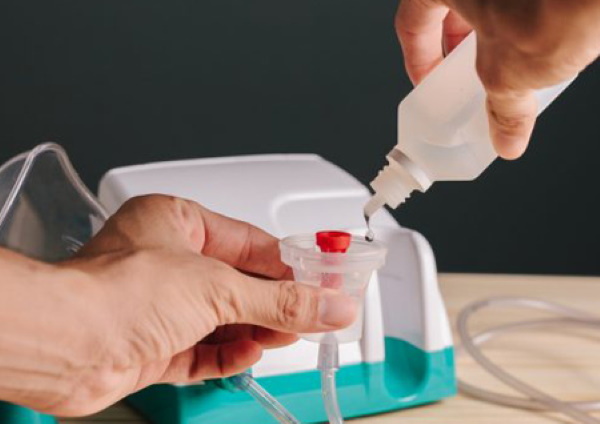
- connect the device to the power supply.
It is not recommended to add essential oils to the solution - an oily film appearing on the surface can damage the device.
The mouthpiece and mask must first be washed with warm water and soap or any disinfectant solution. Saline can be prepared on the basis of sea or table salt (for 1000 ml - 2-3 tbsp. l.). For inhalation, sea salt is more beneficial.
It contains:
- chlorine - participates in the production of hydrochloric acid;
- fluorine - has antimicrobial effect;
- sodium, potassium - helps to cleanse the body at the cellular level;
- manganese - restores the body's defenses;
- iron, zinc - participates in the formation of red blood cells;
- silicon - returns elasticity to blood vessels;
- selenium - minimize the risk of cancer cell growth;
- calcium - has a wound healing strengthening effect.
Before inhalation, the patient needs to measure the temperature. If it is increased, then it is recommended to refuse the procedure.

Warming up is carried out in 90 minutes. before meals or after 90 minutes. after. It is necessary to clear the nose and throat before inhalation. The duration of the procedure for adult patients is 10-15 minutes, for children - no more than 5 minutes. The course of treatment includes 10-15 sessions. 2-3 procedures can be carried out per day.
For contact lenses
The process of preparing the saline solution for lenses takes place in several stages. First of all, special attention must be paid to the sterility of instruments and containers.
The disinfection process also takes place in several stages:
- Dust and other contaminants must be removed from the work surface. To do this, wipe the tabletop with alcohol, rinse the necessary tools in warm water using a cleaning or detergent.
- Antibacterial treatment is carried out with 70% alcohol. The solution is used to wipe the container intended for storing the lenses, a measuring container (teaspoon or tablespoon). 70% alcohol can be replaced with chloramphenicol, formic or salicylic.
Plastic containers cannot be sterilized, so they should be kept for 25-30 minutes. placed in a solution of alcohol, then taken out, rinsed and wiped dry. Sterilization, as the final stage of disinfection, allows you to completely destroy pathogens. Tools made of heat-resistant material can be boiled or heated in the oven.
Metal, glass objects are lowered into cold water. Boil the instruments for 20-30 minutes. Additionally, they can be doused with steam. After sterilization, iron objects are usually pierced. To do this, lay out the tools on a baking sheet covered with foil and place them in the oven for 15 minutes.
Required Ingredients:
- salt - 1 tsp l .;
- boiled, cooled water - 250 ml.
Table salt is added to water in small portions, constantly stirring the solution. Lenses can be placed in it only after the crystals are completely dissolved. The saline solution should be completely transparent, without sediment. The liquid is slightly warmed up before placing soft lenses in it.

If during wearing a person feels discomfort (burning, itching), then it is necessary to immediately remove the lenses. It is strictly forbidden to store products in a saline solution for people suffering from diseases of the organs of vision (blepharitis, barley, conjunctivitis).
How to dilute the solution?
At home, you can make saline only from distilled water. During the preparation process, it is important to adhere to the proportions so that the saline solution does not turn out to be concentrated. For inhalation or rinsing the nose, throat, you can prepare a saline solution, which contains several components. They are also allowed to be consumed orally during poisoning and dehydration.
Popular options:
- Option 1. Table salt (3.5 g), baking soda (2 g), potassium chloride (1.5 g) and glucose (18-20 g) are added to boiled cooled water (1000 ml). The solution is thoroughly mixed until the crystals are completely dissolved.
- Option 2. Table salt (2.5 g), sodium citrate (2.8 g), potassium chloride (1.5 g) and glucose (13 g) are added to warm water (1000 ml). The solution is thoroughly mixed.
- Option 3. Sugar (18 g) and table salt (3 g) are added to warm boiled water (1000 ml). The solution is stirred until the crystals are completely dissolved.
Physiological solutions prepared according to the above recipes are most effective for dehydration.
How to warm up the solution?
It is best to warm the solution before rinsing the nose or inhaling. It is strictly forbidden to boil it, therefore, the desired temperature (no more than 50 ° C) is achieved through a water bath.
Algorithm of actions:
- cold water is poured into a bowl with thick walls:
- the solution is poured into a smaller pan.
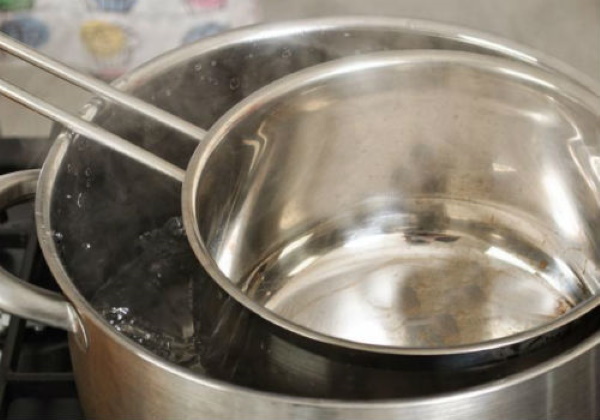
After the water has boiled, carefully place the smaller cookware in the first pan. It is important to ensure that water does not spill out during the heating process and extinguish the fire. To determine the temperature, you can use a special thermometer.
Inhalation dosage
You can make saline at home using several types of salts. The product is non-toxic, so inhalations can be carried out up to 4 times a day. It is enough to pour 3-5 ml of solution into the tank. If you intend to use drugs (mucolytics, bronchodilators), then the dosage regimen must be observed. It is selected individually, depending on the patient's age and diagnosis. Usually a few drops of the drug (syrup, suspension, solution) are enough.
Adding other medications
In diseases of the bronchopulmonary system (bronchial asthma, chronic pulmonary obstruction), the patient is usually prescribed inhalations with saline and Berodual. In the composition of Berodual there are 2 main components ipratropium bromide and fenoterol.
The latter has a complex effect on bronchial adrenergic receptors, significantly expanding their lumen. Bromide is responsible for ensuring the normal functioning of the smooth muscles of the respiratory system. The drug is characterized by a bronchodilator effect.
Contraindications for inhalation are:
- hypertension;
- cardiomyopathy;
- ischemic heart disease;
- arrhythmia;
- tachycardia;
- the period of bearing the child and breastfeeding;
- individual intolerance to active or auxiliary components;
- thyrotoxicosis;

- angle-closure glaucoma.
The dosage regimen is selected individually by the attending physician. The therapeutic norm is mixed with saline (2-4 ml of sodium chloride). Inhalation with saline and Lazolvan contributes to the evacuation and dilution of sputum. The drug has a pronounced expectorant effect.
Indications for appointment:
- chronic lung obstruction;
- asthma, accompanied by a hacking wet cough;
- chronic and acute bronchitis;
- unilateral, bilateral pneumonia.
Lazolvan has several dosage forms: tablets, lozenges, syrup, saline. For people suffering from hypersensitivity, as well as for pregnant and breastfeeding women, inhalation with Lazolvan is contraindicated. According to reviews, the drug is well tolerated. Overdose cases have not been identified during clinical trials.
For diseases of an inflammatory and allergic nature (damage to the bronchi or lungs), the patient is prescribed Pulmicort. A corticosteroid can be added to saline before inhalation.
The main indications for the appointment:
- laryngitis;
- chronic lung obstruction;
- seasonal hay fever;
- bronchial asthma.
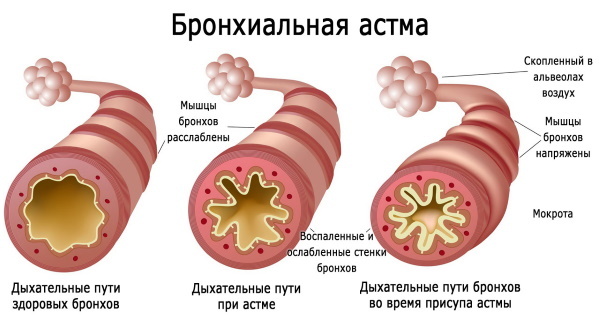
The drug has a number of contraindications.
These include:
- individual intolerance to the main component;
- pathology of the respiratory system of the bacterial and fungal type;
- liver disease (including acute failure and cirrhosis);
- tuberculosis (in active form);
- children's age (up to 6 months).
The Pulmicort suspension must be added to the saline solution. The finished product is used within 20-30 minutes. After inhalation, rinse the mouth thoroughly with warm water. If the patient inhaled steam through the mask, then after the session the face is also washed.
The following categories of drugs can be added to saline for inhalation:
- vasoconstrictor - inhalation is prescribed for severe swelling and shortness of breath;
- antiseptics - the procedure is indicated for patients suffering from diseases of the upper and lower respiratory tract of inflammatory etiology;
- antibiotics - inhalation is prescribed for diseases, the causative agents of which are considered to be pathogenic microorganisms.
For children, inhalation is carried out with saline and preparations based on Ambrohexal. In this case, 1-2 drops of the drug are added to 2 ml of saline. The ready-made solution cannot be stored for a long time. Experts recommend preparing the drug just before inhalation. It is not recommended to keep the nose and throat rinse in the refrigerator.
Komarovsky's advice
Dr. Evgeny Komarovsky does not recommend inhalation for children with mild colds. If only saline is poured into the nebulizer, then the steam that the child inhales does not heal, but simply moisturizes the respiratory tract.
The main indications for the use of an inhalation device for children:
- bronchial asthma;
- bronchiectasis;
- severe cough caused by allergies;
- chronic and acute bronchitis;
- laryngitis;
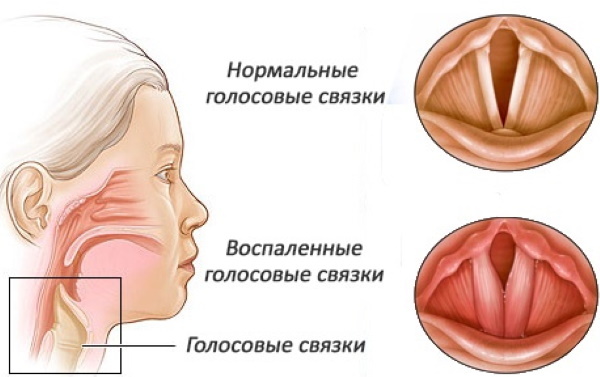
- cystic fibrosis (bronchopulmonary form);
- pharyngitis.
During the inhalation of steam, the upper and lower respiratory tract is sanitized. The procedure will be effective for bronchospasm. After the nebulizer, the microcirculation process in the mucous membranes is restored. Inhalation helps to strengthen the body's defenses. It is possible to add medicine to saline only with the permission of the attending physician. He will independently select a dosage regimen depending on the diagnosis.
The child can be inhaled using alternative medicine (propolis, chlorophyllipt). It is necessary to make a saline solution from salt and distilled water at home in compliance with all proportions. If necessary, add baking soda, glucose or iodine to it. Additional components enhance the therapeutic effect of the solution.
Video on how to make saline
How to make a saline solution for home rinsing:
